Associated Humane Societies often publishes emotional stories about the organization heroically rescuing animals from terrible situations in Newark. Typically, these stories are found on the AHS web site and/or their Humane News publication. These fundraising efforts are lucrative as AHS brought in an impressive $3.6 million in donations and grants for the fiscal year ended June 30, 2014. The 2003 New Jersey Commission of Investigation report on AHS stated the organization’s fundraising campaigns did not fairly represent the care typically provided to animals:
The substandard conditions and treatment of the animals, which existed on a large scale until recently, betrayed AHS’s massive fundraising campaign through the years and contradicted AHS’s persona as a “humane” organization. Bernstein capitalized on the plight of animals to garner millions of dollars in contributions, but failed to apply any portion of those millions to establish a satisfactory level of care and treatment.
Are these fundraising stories representative of the care most Newark animals receive at AHS-Newark now? Has AHS-Newark improved enough since the 2003 New Jersey Commission of Investigation report was issued?
Additional Animal Control Contracts and Summary Statistics Raise Serious Concerns
In 2014, AHS-Newark added a number of municipalities, such as South Orange and Maplewood (both towns no longer contract with AHS-Newark) and the cities and towns formerly contracting with Linden Animal Control. Despite already killing large numbers of animals, AHS-Newark decided to contract with all these additional municipalities and receive substantial fees in return. In February 2015, AHS-Newark Assistant Executive Director, Scott Crawford, stated his organization could handle the additional animals.
The shelter’s annual summary statistics showed it impounded and killed more animals in 2014 verses 2013. Animal intake increased from 5,019 dogs and cats in 2013 to 6,194 dogs and cats in 2014. AHS-Newark reported the number of dogs and cats that were killed, died or went missing increased from 1,962 in 2013 to 2,356 in 2014. As a result, AHS-Newark literally earned more revenue by impounding and killing significantly more animals in 2014 verses 2013.
Detailed Analysis Conducted
To get a better understanding of AHS-Newark’s handling of animals, I submitted an OPRA request to the City of Newark’s Animal Control Department seeking intake and disposition records of animals the city’s Animal Control Department impounded in 2014. The City of Newark picks up animals during normal working hours and delivers most animals to the AHS-Newark shelter. At other times, AHS-Newark ACOs perform these duties. The records do not include direct owner surrenders to the shelter from Newark residents (except for a few that were included), but do include people surrendering their animals to animal control who then take the animals to AHS-Newark. After much follow-up over a period of several months, I received AHS-Newark’s underlying intake and disposition records for the animals originating from animal control in Newark.
In total, I obtained around 3,000 pages of records and it took me several months to review and summarize this information. Many of these records were for wildlife, animals leaving before animal control officers arrived, and animals that were dead by the time the animal control officer got to the location. Overall, I reviewed the intake and disposition records of 966 cats and 649 dogs that AHS-Newark impounded in 2014. These records constituted 23% of the dogs and 28% of the cats AHS-Newark reported taking in during 2014.
I reviewed each record and summarized my findings. My summary included the animal’s ID number, species, breed, origin (stray, owner surrender, confiscated by authorities), intake date, outcome date, length of stay, outcome, reasons for killing, miscellaneous information, and any comments I had. I only counted the two primary reasons for killing, but generally mentioned other reasons listed in my notes.
AHS Newark’s Underlying Records Reveal Horrors
Honestly, when I received the information I thought the City of Newark forgot to provide me the records for animals making it out of the facility alive. However, the records included some animals who were adopted out and rescued. The records I obtained listed 229 additional animals I did not receive information for. Even if all these other animals made it out of AHS-Newark alive, the dog and cat kill rate based on intake would only drop nine percentage points. My records indicated AHS-Newark impounded 5.8 dogs and cats per 1,000 residents (6.6 dogs and cats per 1,000 people if I include the 229 missing animal records) that came from animal control in Newark. As a comparison, AHS-Newark impounded 4.3 dogs and cats per 1,000 residents from animal control in Irvington per a summary spreadsheet that AHS prepared. If I assume 43% of AHS-Newark’s animals from the City of Newark came from other sources (i.e. owner surrenders, people finding animals on street, etc), which is the percentage from nearby Irvington, then AHS-Newark would take in 10.2 dogs and cats per 1,000 residents (11.6 dogs and cats per 1,000 people if I include the 229 missing animals) from all sources in Newark. This figure is around the same as, if not a bit higher than, other demographically similar cities in the area. Additionally, I submitted another OPRA request for any missing animals to the City of Newark and was told no other records existed. While I can’t say for sure if my data set contains the overwhelming number of animals AHS-Newark obtained from animal control in Newark, I think it represents a very large percentage.
The sheer number and percentage of animals losing their lives at AHS-Newark is staggering. Overall, AHS-Newark killed 79% of the cats, 63% of the dogs, and 74% of the pit bull like dogs in this data set. Furthermore, if I add animals who died at AHS-Newark and only count known outcomes, 93% of cats, 70% of dogs, and 81% of pit bull like dogs in this data set lost their lives at AHS-Newark. To put it another way, 855 out of 919 cats, 424 out of 608 dogs, and 329 out of 408 pit bull like dogs lost their lives per these records. As a result, these records indicate AHS-Newark operated more like a death camp than an animal shelter for the dogs and cats coming to the facility from animal control in the City of Newark.
Even if the death rate for animals from Newark Animal Control was actually lower due to the City of Newark not providing me additional records, my analysis still shows AHS-Newark killed vast numbers of healthy and treatable animals.
Results Raise Question About AHS-Newark’s Reported 2014 Statistics
These results show AHS-Newark disclosed erroneous statistics to the New Jersey Department of Health. In AHS-Newark’s 2014 Shelter/Pound Annual Report, the organization stated 12 dogs and 92 cats died or went missing. However, my data set, which only includes 23% of the dogs and 28% of the cats AHS-Newark impounded during the year, had both more dogs (13) and cats (96) dying in the shelter in 2014 than AHS-Newark reported for all of its dogs and cats. If I add the animals where a “Not Available” outcome is listed, the number of animals dying or going missing rises to 15 dogs and 101 cats. Furthermore, my data set accounted for 50% and 53% of the number of dogs and cats AHS-Newark reported to kill despite only making up 23% and 28% of the number of dogs and cats AHS-Newark reported it impounded in 2014. While AHS-Newark may kill dogs and cats from the City of Newark at a higher rate than animals coming in from other jurisdictions, I find it hard to believe the kill rate is that much higher for Newark animals, particularly cats. In addition, AHS-Newark reported it impounded the exact same number of dogs (2,794) and cats (3,400) that had outcomes for the year. Frankly, I find that pretty hard to believe given AHS-Newark stated it held over 200 dogs and 200 cats at the shelter during the beginning and end of the year. Thus, this data raises concerns that more animals are losing their lives at AHS-Newark than the shelter is reporting.
AHS-Newark Quickly Kills Animals
In February 2015, AHS-Newark Assistant Executive Director, Scott Crawford, bragged about his shelter’s capacity and the extra time the facility had to place animals compared to some other local alternatives. Based on my review of the above records, AHS killed cats and dogs arriving from Newark Animal Control in January 2014 within 30 days and 27 days on average:
After AHS-Newark took over the cities and towns formerly contracting with Linden Animal Control in November 2014, AHS-Newark killed cats and dogs impounded from Newark Animal Control in this data set much more quickly. Despite Mr. Crawford’s assertion in early February 2015, AHS-Newark rapidly killed cats and dogs impounded from Newark Animal Control in this data set two months before he made this outlandish claim. Based on my review of these records, AHS-Newark killed cats and dogs impounded from Newark Animal Control in December 2014 within 13 days and 11 days on average:
As a result, AHS-Newark’s assertion that it keeps many animals alive a long time is not consistent with the data I examined for dogs and cats arriving from Newark Animal Control.
Absurd Justifications for Killing
AHS-Newark used many poor excuses to kill animals. The top four reasons AHS-Newark used to kill cats were as follows:
- Sick
- Aggressive, unfriendly and feral
- No reason listed
- Ringworm
AHS-Newark’s cats were often sick due to an Upper Respiratory Infection (“URI”) or the common cold. Countless records stated AHS-Newark killed the cat due to the animal “not responding to treatment.” With so many animals getting sick and not getting better, one has to wonder what kind of disease control program AHS-Newark has?
Several examples illustrate AHS-Newark’s inability to medically treat cats with colds. Toots was surrendered to AHS-Newark due to her owner no longer being able to care for her. Despite being a young cat less than 3 years old, AHS-Newark stated they had to kill her within 10 days of arriving at the shelter. While the intake and disposition record states Toots was not responding to treatment for her URI, the veterinary log on this record only mentions the standard vaccinations, deworming and Frontline flea and tick medication received on the day she arrived at AHS-Newark. The veterinary log then mentions she was poisoned to death with Fatal Plus 10 days later. Call me crazy, but I don’t see any documentation of any additional veterinary treatment for her URI on this record.
Brooklyn was an 11 month old cat described as “very sweet” by AHS-Newark. Yet, within 11 days of arriving at the shelter, AHS-Newark killed her due to a “very bad URI” that did not get better. However, once again the veterinary log on this record did not describe any specific treatment for her cold after her vaccinations on the day she arrived.
Moonlight was a 15 month old stray cat and described by AHS-Newark as “very beautiful, sweet and trusting” and “wants love and attention.” Yet, AHS-Newark killed her 16 days after her arrival at the shelter due to her having a “URI” and being “weak and lethargic.” Other than two rounds of the standard shelter vaccinations and deworming, AHS-Newark once again provided no other treatment specifically for the URI per the veterinary log in this record.
The records did not indicate AHS-Newark sent any of these cats to an isolation area for treatment, reached out to any rescues or tried to place the animals in foster homes to recover from their illness. Thus, AHS-Newark failed all three cats, as well as many others, who were highly adoptable.
AHS-Newark labeled many cats feral and/or unadoptable for dubious reasons. Notably, the shelter provided inadequate amounts of time to socialize fearful cats who were justifiably scared in this high kill shelter. Furthermore, I saw no efforts to socialize virtually all of these cats on their records. In fact, AHS-Newark often classified owner-surrendered cats, who presumably lived in or around homes, as feral or otherwise unsuitable for people to adopt. For example, Baby Girl was a 3 and half year old cat surrendered due to her owner moving. AHS-Newark labeled this cat a “wild” and killed her within just 8 days of arriving at the shelter. In addition, AHS-Newark did not vaccinate her upon intake and therefore increased the risk of disease among the shelter’s cat population.
Me Me was surrendered by her owner due to the owner not having room for the cat. Once again AHS-Newark labeled the cat as “wild”, did not vaccinate her, and killed her within 9 days:
Lucky, who was nearly 9 years old, was surrendered due to her owner not being able to care for her any longer. Despite this cat most likely having lived in or around a home for many years, AHS-Newark labeled her as “wild”, did not vaccinate her, and killed her after just 7 days.
Thus, AHS-Newark’s labeling of cats as feral, aggressive and otherwise unadoptable is highly suspect.
AHS-Newark used a “throw everything but the kitchen sink” approach to justify the mass killing of dogs. Often times the shelter listed multiple boilerplate reasons, like aggression (including “cage crazy”/”not kenneling well”), dog aggression, sick, etc. The top five reasons AHS used to kill dogs were:
- Aggression related issues
- Sick
- Dog aggression
- No reason listed
- Overcrowded
While certainly some dogs likely were truly aggressive, many dogs labeled as such did not seem that way. Sadie was a nearly 4 year old pit bull mix with a very good behavioral evaluation. The evaluation stated Sadie was “playful, loving and affectionate once she gets to warm up.” The evaluation also stated Sadie “allows you to handle her from head to tail without complaint” and “she is easy taking treats and likes to share her toys.” Yet, just over one month later, “SC”, who I presume is AHS Assistant Executive Director, Scott Crawford, approved her killing for “becoming temperamental.” The record provided no elaboration on what her exact problems were nor did the record document any efforts to rehabilitate her.
Billy was a 2 year old Plott Hound-Boxer Mix. The dog’s evaluation stated he did not behave well inside his kennel, but “all you have to do is take him outside and he is a totally different dog.” Billy’s evaluation went on to say “he is fine with being handled all over” was “gentle with treats”, had “a great food test” and “seemed fine with the other dogs outside.” Despite this very good evaluation, AHS-Newark decided to kill him exactly 3 weeks later for being “extreme cage crazy”, “becoming hard to handle”, “doesn’t show well” and “no dogs.” AHS-Newark couldn’t even take the time to write a proper sentence to justify killing this young dog. The record provided no documentation that AHS-Newark tried to alleviate his kennel stress or perform any other efforts to rehabilitate him. Simply put, the record indicates AHS-Newark killed Billy for convenience as he didn’t “show well” and was “hard to handle.”
Danny was a nearly 3 year old American Bulldog. He had a good evaluation stating he was “playful”, “good with other dogs”, “knows sit”, and “needs manners.” In other words, Danny was a big playful puppy. In addition, his record states he was a “photo shoot dog.” Just over two months after Danny’s evaluation, AHS-Newark killed Danny and justified it by stating “no dogs” and “insane in kennels.” Once again the record mentions no actions to provide any enrichment to Danny. It doesn’t take a rocket scientist to determine that a high energy dog needs stimulation and exercise. Also, the record provides no details on Danny’s alleged dog aggression which is contradicted by his behavioral evaluation. Even more disturbing, AHS-Newark killed one of the few dogs in this data set with an evaluation (less than 10% of dogs and virtually no cats had an evaluation) and included in a photo shoot. If AHS-Newark kills dogs in the spotlight, what chance do the vast majority of animals that are never seen or heard have?
AHS-Newark’s practice of killing massive numbers of dogs for aggression related issues clearly needs to stop. While some dogs coming into a shelter are a serious threat to people and their problems will not satisfactorily respond to rehabilitation efforts, well-run animal control shelters typically find 5% or fewer of dogs fall into this category. In this data set, AHS-Newark killed 26% of their dogs for aggression related issues plus a number of others for dog aggression. As a result, AHS-Newark is unfairly labeling dogs as aggressive.
AHS-Newark also killed dogs due to lack of space. Qunn’s intake and disposition record described him as “very excitable, but nice” and “kind of wild, but very, very friendly.” Despite this, AHS-Newark killed Quinn for not being able to place him with another dog in a kennel and him being “hyper” and “hard to handle.” The record provides no evidence that AHS gave Quinn any exercise let alone enrichment. Furthermore, AHS-Newark killed Quinn during December which is typically one of the lowest intake months for shelters. Even worse, AHS-Newark killed Quinn for lack of space less than two months before Scott Crawford bragged about his shelter’s large capacity.
Red was a 16 month old dog surrendered to Newark Animal Control by his owner. After just 8 days, AHS-Newark killed him for having a cold and the isolation area being full and for allegedly not being able to house him with other dogs. The intake and disposition record provides no evidence AHS-Newark gave any specific treatment for his URI other than a canine flu vaccine upon intake. AHS-Newark killed Red due to a lack of space just two and half months before Scott Crawford boasted about his shelter’s ability to house lots of animals.
Rambo was a “friendly stray dog” who was killed due to overcrowding. AHS-Newark identified the owner and apparently talked with her. For whatever reason, the owner did not reclaim the animal. AHS-Newark killed Rambo in December, one of the lowest intake months for most shelters, due to “no dogs”, “no response” to the letter to his owner and the main kennel being full. Once again Scott Crawford decided to kill a “friendly” dog due to lack of space just two months prior to him bragging about the large amount of animals his shelter could hold.
AHS-Newark also killed many dogs for no documented reason. Pamtera was apparently abandoned in an apartment. AHS-Newark often publicizes these types of cases in fundraising appeals. After 11 days, AHS-Newark killed Pamtera for no reason other than it being “ok to pts per kp.”
Dog ID# 130078, like most of the animals I reviewed records for, had no name. She was a 6 year old and 5 month old small terrier mix. After just 8 days, AHS-Newark killed her once again for no reason other than being “ok to pts per kp.” Even worse, this record did not state how AHS-Newark killed Dog ID# 130078.
Durango’s evaluation described him as “sweet and affectionate”, “very focused and loving towards all people, but he doesn’t like other dogs”, “genuinely loved to give and get attention” and “a handsome boy with knockout gorgeous eyes.” Furthermore, his intake and disposition record states in bold and in caps “Humane News – February”, “Petfinder”, “Facebook”, “Do Not PTS.” In other words Durango was a fantastic dog and was one of the few dogs AHS-Newark intended to promote. Despite all of these great things going for him, AHS-Newark killed Durango for no reason according to this record.
AHS Hands Animals Over to a Rescue Subsequently Convicted for Animal Cruelty
AHS-Newark has a difficult adoption process in my experience. Typically, AHS-Newark makes people visit the shelter multiple times to adopt an animal. Often, this process can take a number of days. As a result of these policies, animals stay too long at the facility and this increases the chance the shelter will kill animals due to lack of space.
Gabriel Ganter (formerly Gabriel Palacios) was recently convicted of animal cruelty. Ms. Ganter ran Pit Bull Kisses rescue out of Newark until she moved to Dumont. On May 13, 2015, the Bergen County SPCA raided her Dumont home and found dead dogs in garbage bags, a live dog and starved cat on chains without proper shelter (warning: the photos in this link are deeply disturbing). Furthermore, one official stated the conditions insider her house were “horrid.” Ultimately, Gabriel Ganter pleaded guilty to not providing necessary care to animals this month.
Gabriel Ganter’s Pit Bull Kisses Rescue rescued the most animals of any organization in this data set. Pit Bull Kisses rescued 16 of the 35 dogs and cats rescued in the records I reviewed. In all fairness, many people in the animal welfare community were duped by Gabriel Ganter. However, Ms. Ganter began acting erratically in the summer of 2014 and AHS-Newark should have known this. Sadly, AHS-Newark still allowed Pit Bull Kisses to rescue the following dog and cat after this point:
We can only hope this unnamed dog and cat went to other foster homes rather than Gabriel Ganter’s house of horrors.
AHS Fails Newark’s Stray Animals
The sheer amount of killing is mind boggling. Nearly 1,300 dogs and cats just from the City of Newark lost their lives after arriving at AHS-Newark in 2014. Furthermore, that number most likely would be higher if I obtained the records of the over 200 missing animals not provided to me. To put it another way, around 4 dogs and cats just from the City of Newark lose their lives at AHS-Newark on average each day of the entire year. 84% of the dogs and cats in this data set who came into AHS-Newark in 2014 and had outcomes lost their lives. For these animals, AHS-Newark is a slaughterhouse rather than a shelter.
The underlying records I examined reveal no substantial effort to end this pet extermination project. Massive numbers of animals get sick with treatable illnesses and AHS-Newark still kills them. The records I reviewed did not indicate the shelter often seeks foster homes or even places many sick animals in isolation areas. Even worse, not only do animals typically not receive behavioral rehabilitation, but AHS-Newark seems to actively classify animals as aggressive to justify killing those creatures. Worst of all, AHS-Newark placed such a low value on the lives of these animals that shelter staff couldn’t even write complete sentences or even spell correctly on many of these records. When you can’t take the time to properly document the animal’s information on its record, what hope do we have that you will invest the time and energy into saving that dog or cat? Now, perhaps these records are inaccurate, but that raises even more questions? If your records are inaccurate, why should we believe anything you claim?
Clearly, AHS-Newark should never have contracted with additional municipalities when it already killed far too many animals. Frankly, AHS-Newark should have sought ways to reduce intake rather than deliberately bring in more animals in exchange for more animal control and sheltering contract fees. While all three AHS facilities have more than enough space to save its dogs and cats, AHS fails to enthusiastically implement proven programs and policies to perform at these levels. As such, AHS-Newark should have terminated rather than have added animal control and sheltering contracts.
Donors Must Hold AHS Accountable
Donors should demand AHS-Newark comprehensively adopt the no kill equation as countless other animal control shelters successfully have. Animal control shelters in Kansas City, Missouri, Austin, Texas, and Salt Lake City, Utah achieved no kill status and even save around 90% of their pit bull like dogs. Other animal control shelters in poor urban areas, such as in Washington, DC and Baltimore, Maryland, are close to achieving no kill. All of these animal control shelters take in more animals in total and on a per capita basis than AHS-Newark. Additionally, most of these shelters receive less revenue per animal than AHS. Thus, AHS-Newark should do great things.
At the end of the day, donors must wake up and demand AHS change its ways. Apparently, AHS thinks it can dupe its donors into thinking most of the animals it impounds from Newark are heroically rescued and sent to loving homes. Based on the records I reviewed, this absolutely is not the case. AHS must remove its entire senior leadership team, including Roseann Trezza, and replace them with people dedicated to comprehensively implementing the no kill equation. The good people donating to AHS clearly expect the organization to save its animals. It is time donors require AHS to use their hard earned money to save animals and not kill them for convenience and cost savings.
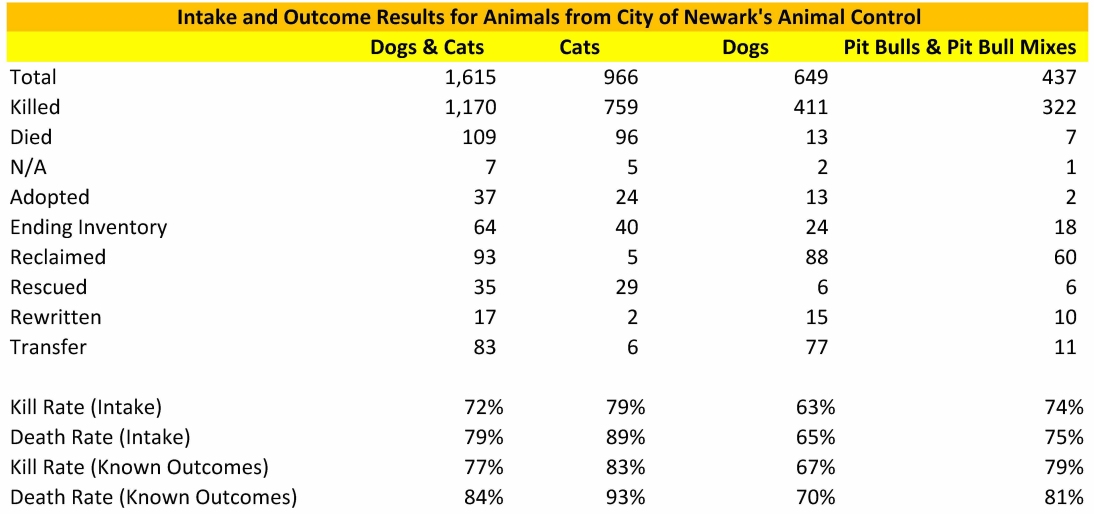



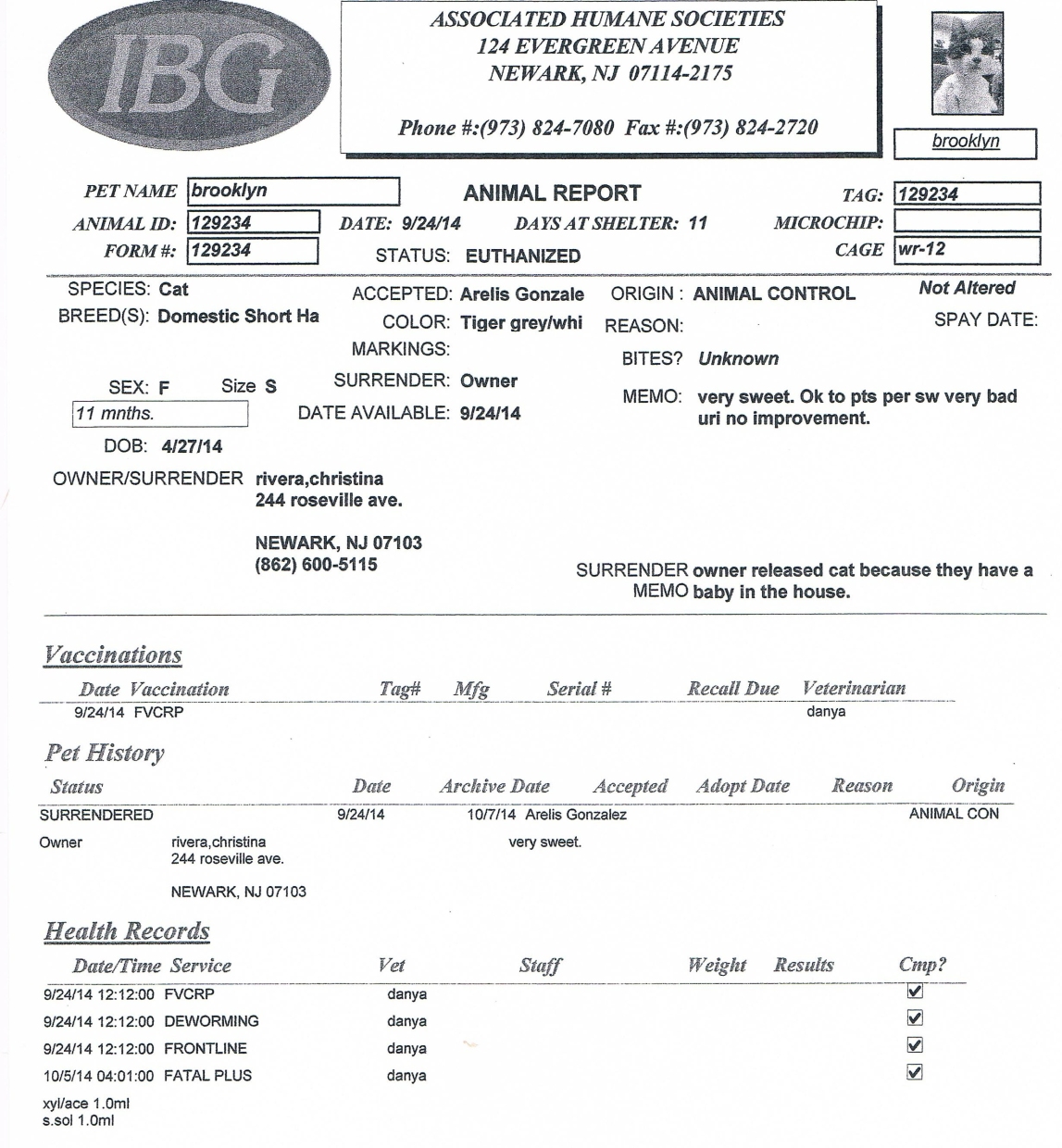





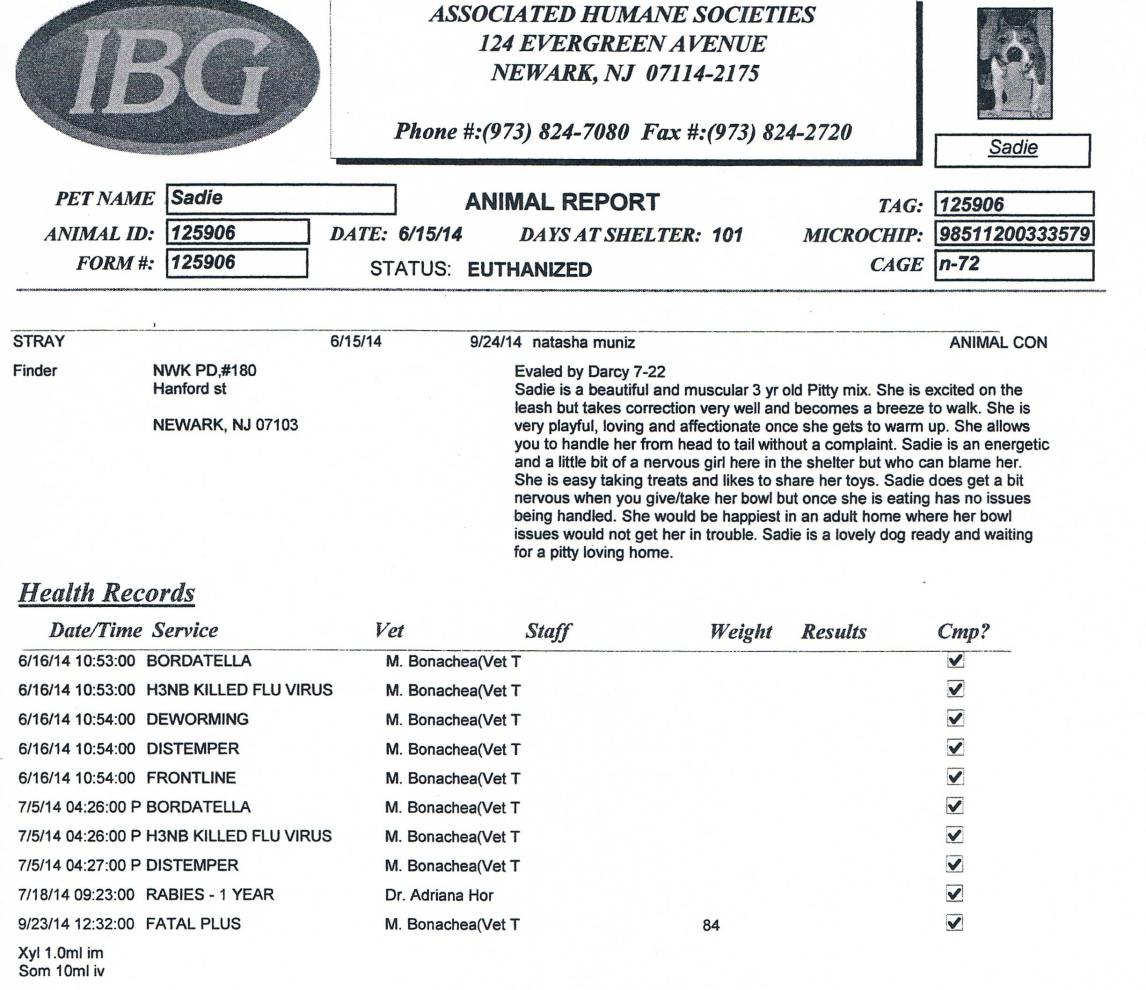







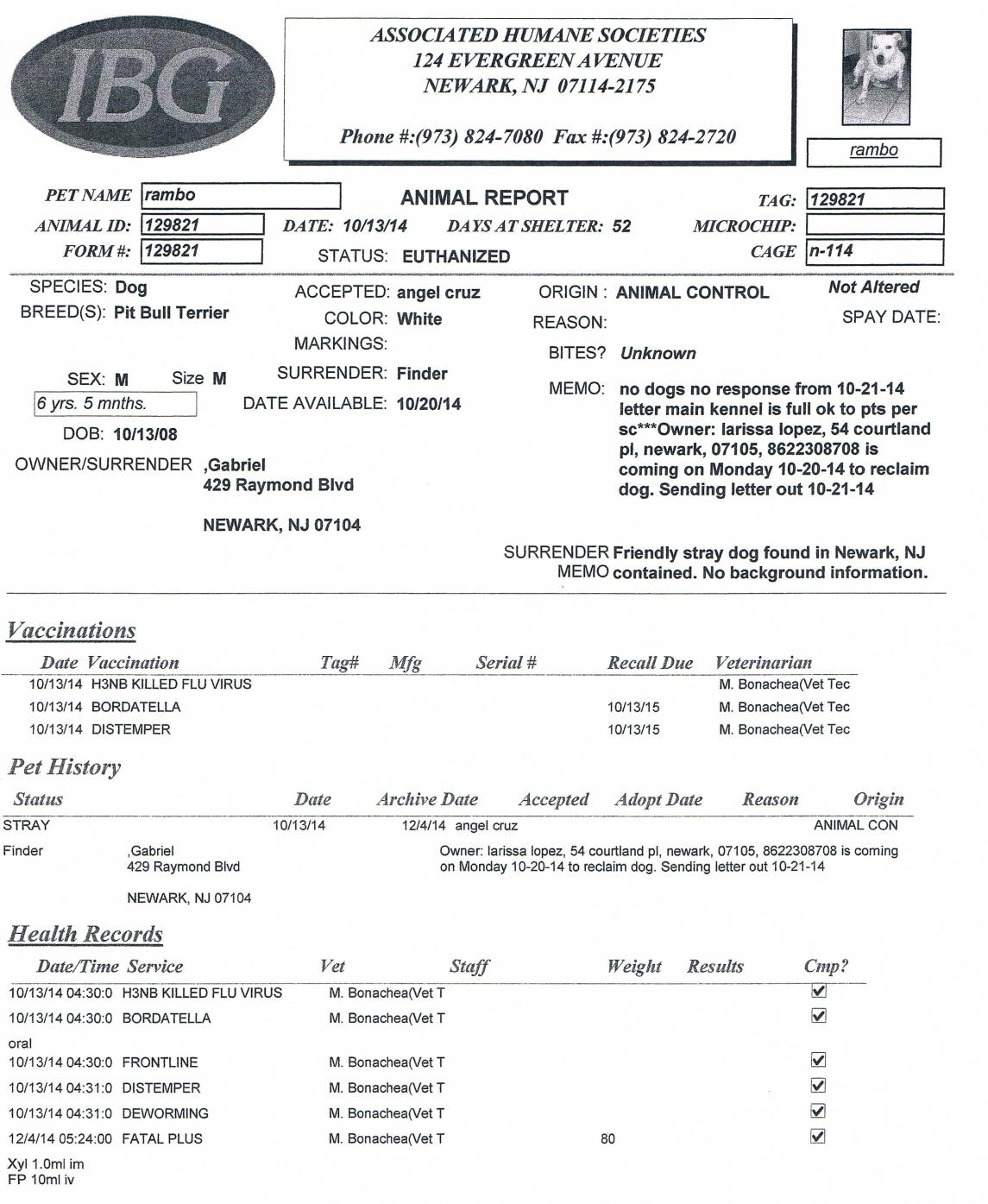

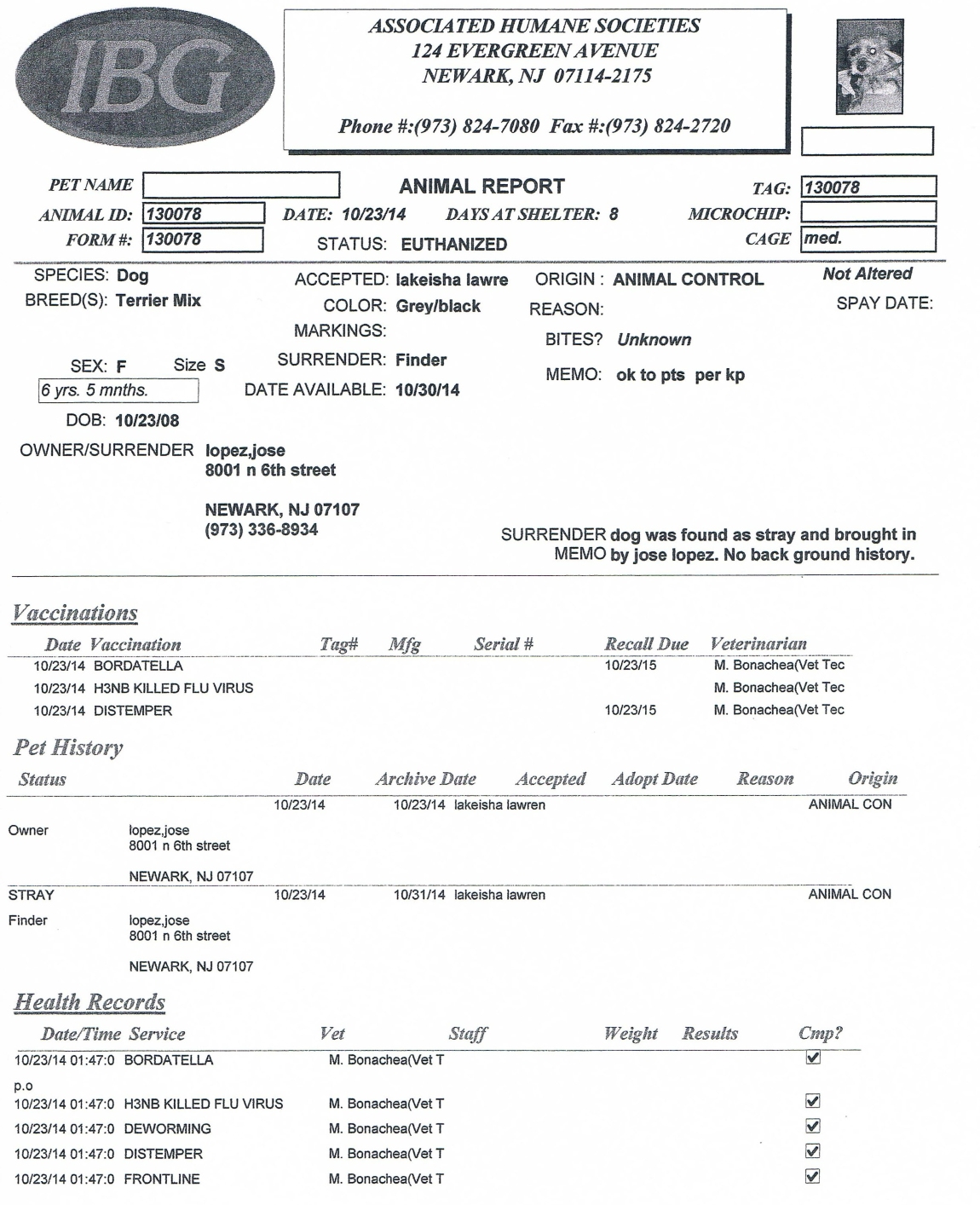
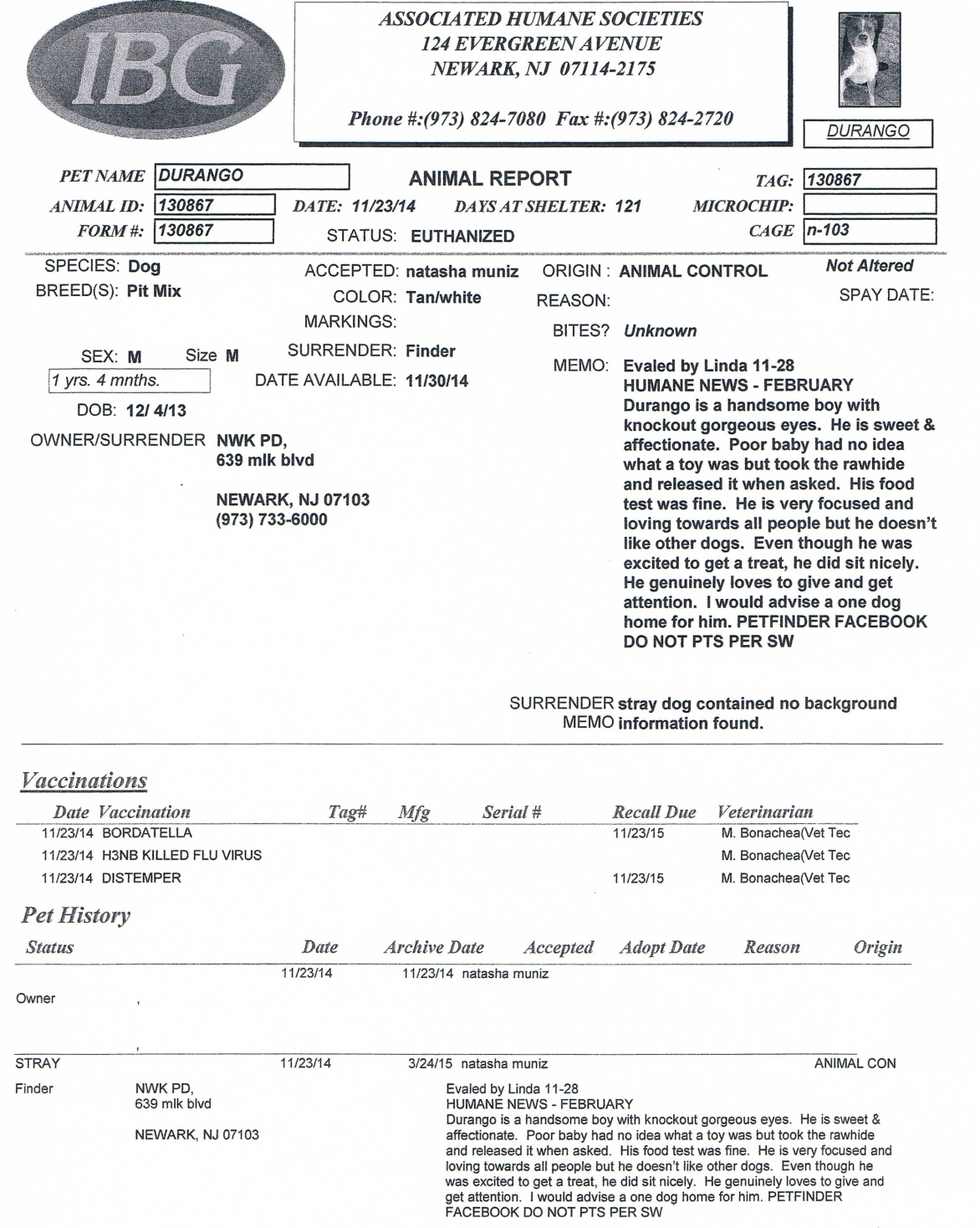

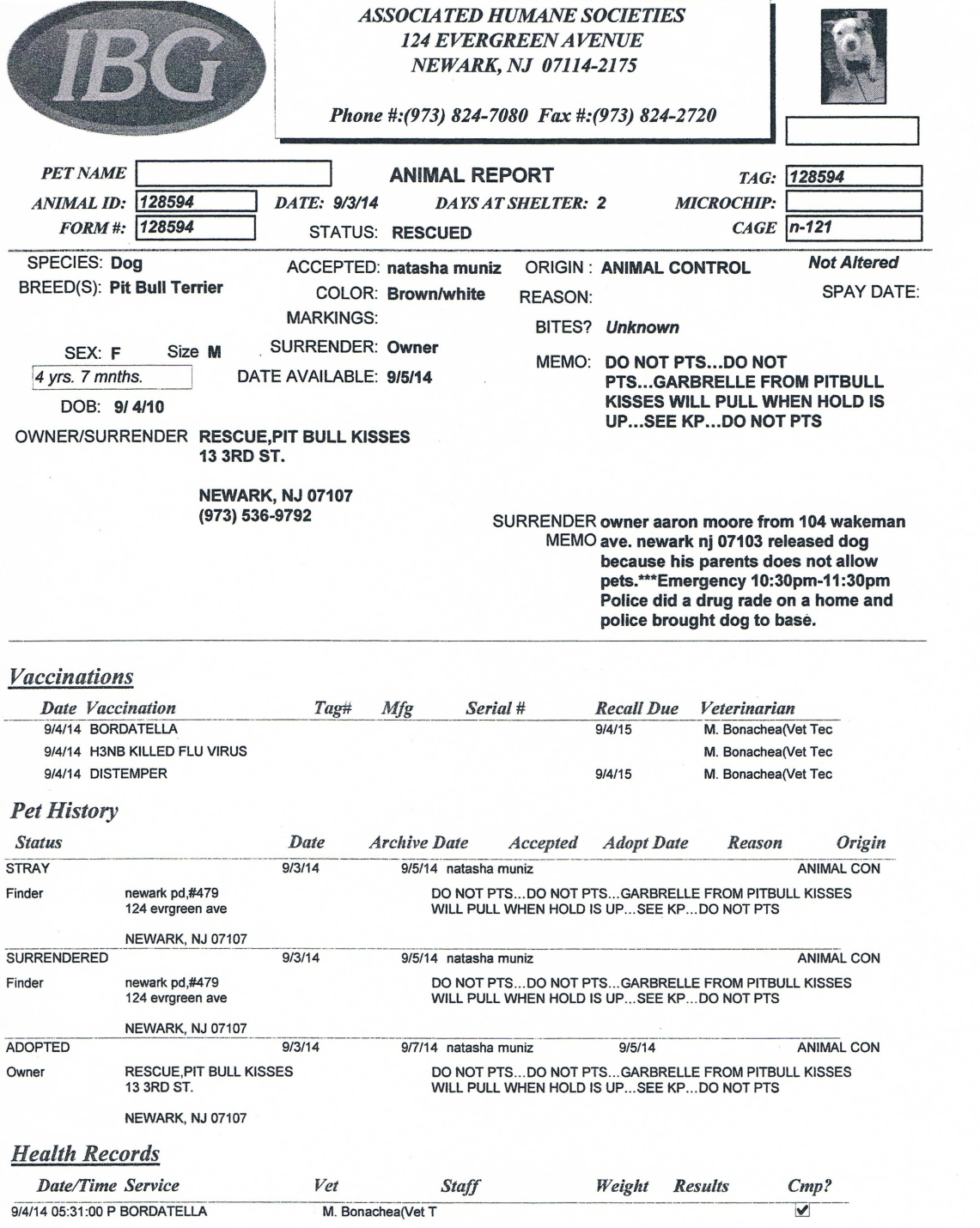
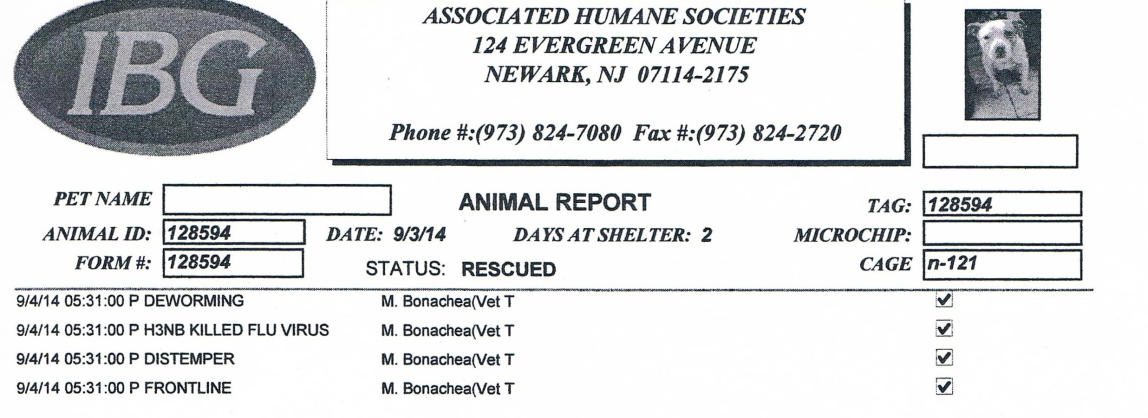

Sick people.
LikeLike
So what is being done about this situation by the municipalities that contracted with AHS
LikeLike
On a positive note, South Orange decided not to contract with AHS-Newark earlier this year. Additionally, AHS-Newark terminated its contract with Maplewood this year due to town officials and the residents of the town criticizing AHS. Sadly, despite Cory Booker’s initiative to build a new shelter in the city, Ras Baraka’s administration has said nothing and still contracts with this shelter.
Unfortunately, I have not seen much action from other municipalities contracting with AHS-Newark. My suggestion is for people to consistently attend local council meetings, contact the press, and demand their cities and towns contract with a shelter that will save all of their healthy and treatable animals.
LikeLike
This is AWFUL and needs to be stopped!! They get paid a certain amount of money by the state for every animal they kill…that is why they would rather kill them them treat them!!
LikeLike
While AHS-Newark profits off the killing (cheaper to kill than shelter), they do not specifically receive money for killing more animals. From the contracts I’ve seen, they get a very large flat fee rather than specific fees for each animal.
LikeLike
Do you know which grants they received? Scott Crawford makes a lot of money to be lazy and incompetent. He is actually crazy
LikeLike
Unfortunately, Schedule VIII of their most recent Form 990 does not provide any details. All contributions and grants are lumped together.
Click to access 990-2014.pdf
LikeLike